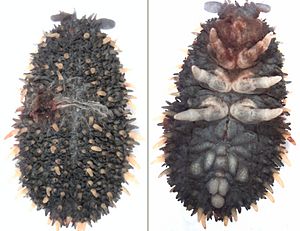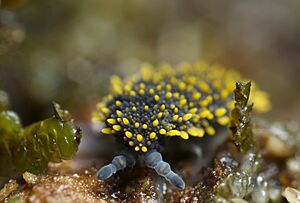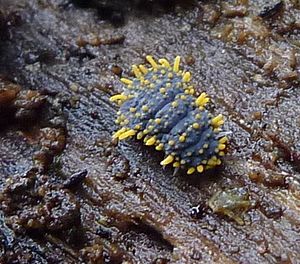Holacanthella facts for kids
Quick facts for kids Holacanthella |
|
|---|---|
 |
|
| Scientific classification | |
| Kingdom: | |
| Phylum: | |
| Class: |
Entognatha (disputed)
|
| Subclass: | |
| Order: |
Poduromorpha
|
| Superfamily: |
Neanuroidea
|
| Family: |
Neanuridae
|
| Subfamily: |
Uchidanurinae
|
| Genus: |
Holacanthella
Börner, 1906
|
Holacanthella is a special group of giant springtails. These amazing creatures are found only in New Zealand. They are known for being the biggest springtails in the world, growing up to 17 millimeters long! That's like the length of a small button.
What Do Giant Springtails Look Like?

Holacanthella springtails are usually dark blue-grey. They have unique, bright, spine-like bumps on their skin. These bumps are called digitations. The digitations can be many colors, like dark, white, yellow, or red. Even within the same species, like H. paucispinosa, you can find different color types. Their colors can also change depending on where they live.
Most other springtails are very tiny, only about 1 to 3 millimeters long. But Holacanthella are much bigger! They usually measure 6 to 10 millimeters. Some H. duospinosa have even been found to be 17 millimeters long. This makes them the largest known springtails on Earth.
Unlike most springtails, Holacanthella do not have a special jumping organ called a furcula. This means they cannot jump away from danger.
Where Do Giant Springtails Live?
Holacanthella are decomposers. This means they help break down dead things in nature. They mostly eat rotting hardwood logs. You can only find them in native forests in New Zealand. They prefer old, healthy forests that have never been cut down.
These giant springtails seem to be missing from forests that have regrown after being logged. This might be because they are not very good at moving back into old homes. So, finding Holacanthella in a forest can be a sign that the forest is very healthy and untouched.
Types of Holacanthella Species
There are several known species of Holacanthella:
- Holacanthella spinosa (Lubbock, 1899)
- Holacanthella paucispinosa (Salmon, 1941)
- Holacanthella brevispinosa (Salmon, 1942)
- Holacanthella duospinosa (Salmon, 1942)
- Holacanthella laterospinosa (Salmon, 1944)


